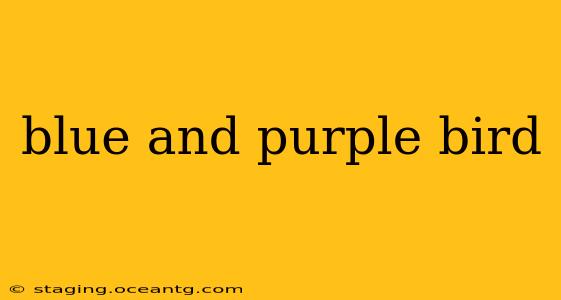The vibrant world of avian species boasts a stunning array of colors, and the combination of blue and purple is particularly captivating. Many birds showcase these hues, either as their dominant coloration or as accents in their plumage. This article delves into the fascinating world of blue and purple birds, exploring various species and the reasons behind their striking appearances.
What Birds Are Blue and Purple?
Several bird species exhibit beautiful blends of blue and purple, often varying in intensity and shade depending on the species and the angle of light. Some of the most notable examples include:
- Purple Gallinule: This striking bird is a vibrant mix of deep purple, blue, and green, with bright red accents on its beak and frontal shield. Its plumage is iridescent, meaning the color shifts depending on the light.
- Purple Swamphen: Similar in appearance to the Purple Gallinule, but slightly larger, the Purple Swamphen is also known for its vivid purple and blue feathers.
- Blue-crowned Motmot: While predominantly green, this bird has a stunning blue crown, a striking feature that contributes to its unique look. Different subspecies may exhibit varying shades of blue.
- Violet-crowned Woodnymph: This hummingbird boasts a captivating violet crown that shimmers in the sunlight, a beautiful contrast to its mostly green body.
- Various Blue Jays: Although the name suggests only blue, some blue jay subspecies show hints of purple tones in their plumage, particularly in certain lighting conditions.
It's important to note that the exact shades of blue and purple can vary greatly depending on species, age, sex, and even individual variation within a species. The appearance is often influenced by iridescence, where the feathers' structure causes the light to refract and create a shimmering effect.
Why Are Some Birds Blue and Purple?
The vibrant colors of birds often serve multiple purposes:
- Camouflage: In some cases, blue and purple hues can provide camouflage in specific environments. For example, a bird living amongst purple flowers might benefit from blending in with its surroundings.
- Sexual Selection: Bright, striking colors are often used to attract mates. Males of many species utilize vibrant plumage to demonstrate their fitness and attract females. This can lead to a competition for the most intense and attractive colors.
- Species Recognition: Distinct colors can help birds identify members of their own species, aiding in mate selection and preventing interbreeding with other species.
- Warning Signals: In some instances, vibrant colors can serve as a warning to potential predators, indicating toxicity or unpleasant taste.
What Do Blue and Purple Birds Eat?
The diets of blue and purple birds vary greatly depending on the species. Some are insectivores, feeding primarily on insects and other invertebrates. Others might be omnivores, incorporating fruits, seeds, and small vertebrates into their diets. Some species, like the Purple Gallinule, are even known to eat snails and crustaceans. Detailed dietary information is specific to each bird species.
Where Do Blue and Purple Birds Live?
The habitats of blue and purple birds are diverse, reflecting the broad range of species that exhibit these colors. They can be found in wetlands, forests, grasslands, and even urban areas, depending on their specific needs and adaptations. Geographic location also plays a major role; some are found in tropical regions, while others inhabit temperate zones.
Are Blue and Purple Birds Rare?
The rarity of a blue and purple bird depends entirely on the specific species. Some, like the common Blue Jay (while not intensely purple, showing hints of it), are widespread and abundant. Others, however, may be quite rare and face conservation challenges due to habitat loss or other threats.
This exploration only scratches the surface of the diverse world of blue and purple birds. Further research into individual species will reveal even more fascinating details about their behavior, habitats, and the ecological roles they play. The beauty and complexity of these birds are a testament to the wonders of the natural world.
